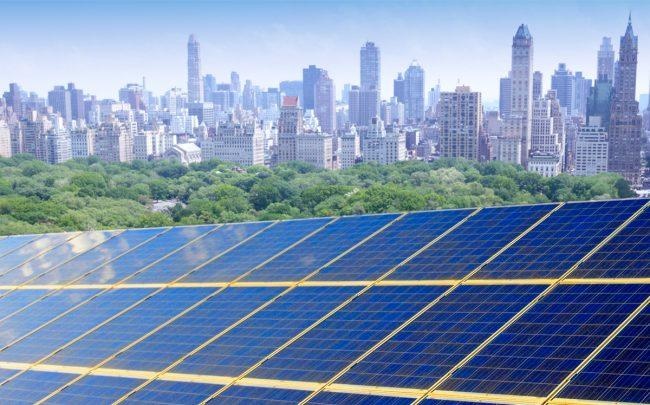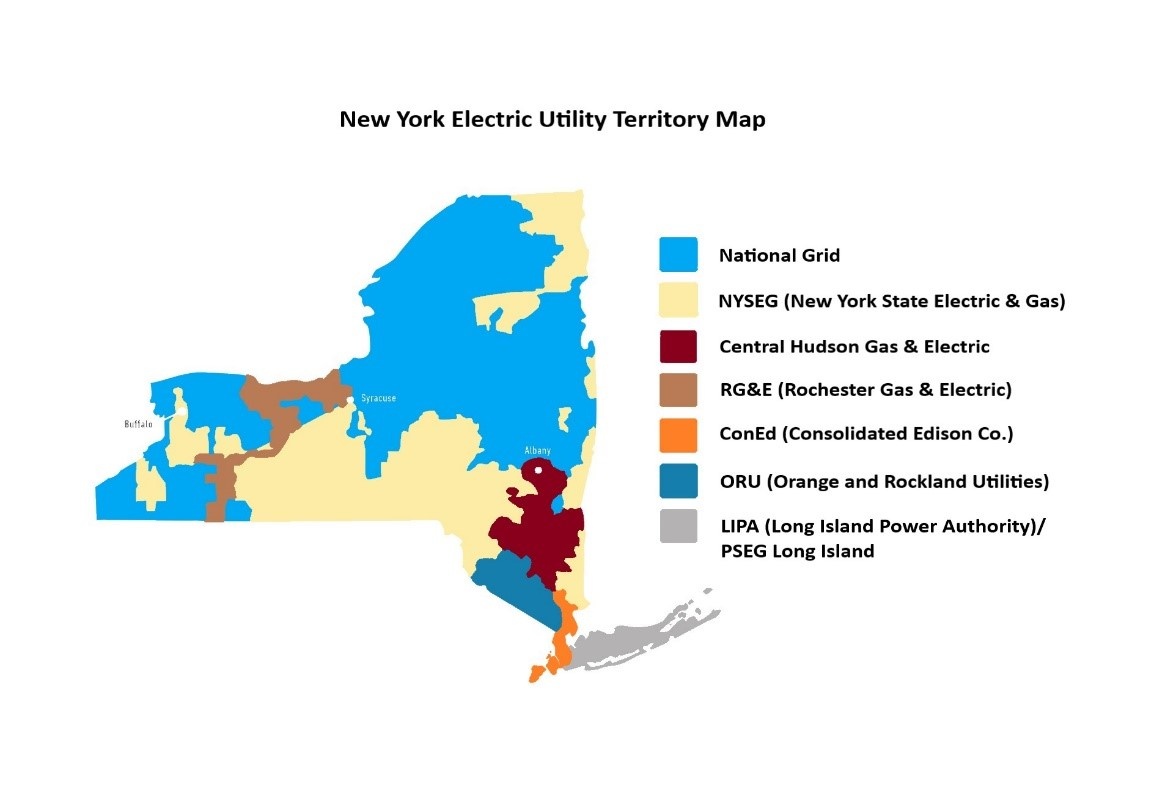New York’s solar and energy storage market has evolved significantly in recent years, which we summarized in a previous blog where we unpacked the policies and initiatives driving the market forward. To successfully deploy projects in New York, developers first need to be able to interpret the technical language that the Empire State speaks. In this blog, we summarize the most important acronyms and entities that developers operating in the New York market need to know. We’ve also compiled a list of essential online resources at your disposal that will help you navigate the solar + storage market waters of New York.
Key acronyms
VDER (Value of Distributed Energy Resources): A replacement for net energy metering in New York State. This is the mechanism used to value customer-sited energy exported to the grid. Also known as the Value Stack, each kWh exported to the grid receives a given value based on the following:
- LBMP (Location Based Marginal Price): Otherwise known as Energy Value. The day-ahead wholesale price of energy based on the load zone you are in. The price fluctuates hourly and is determined by NYISO.
- ICAP (Capacity Value): As it pertains to the Value Stack. The value of how well an energy resource can produce power during New York State peak demand periods. Rates change monthly, and developers can choose from three alternatives for how compensation is calculated.
- E (Environmental Value): The value of the environmental benefits the energy resource provides to the grid. Rate is based on the higher of NY’s Tier 1 renewable energy certificate (REC) value or the social cost of carbon (SCC) and is locked in for 25 years.
- DRV (Demand Reduction Value): The value determined by how much an energy resource reduces the utilities peak demand and future needs for grid upgrades. Rate is locked in for the first 10 years of a project.
- LSRV (Locational System Relief Value): The value available in designated congested load areas with-in a utility where distributed energy resources provide added benefit to the grid. Rate is locked in and only available for the first 10 years of a project.
- CC (Community Credit): The credit available on a limited basis and serves as the successor to the Market Transition Credit (MTC). These credits are designed to promote the development of Community Distributed Generation (CDG) projects. Rate is locked in for 25 years. For territories that have exhausted the credit, NY-Sun will offer and upfront Community Adder to eligible projects.
CDG (Community Distributed Generation): The NY Public Service Commission defines this as “Eligible generating facilities located behind a nonresidential host meter coupled with a group of off-takers (Satellite Accounts) who receive bill credits based on the generation of that facility.” A given CDG project must be less than 5MW and must have a minimum of 10 off-takers located in the same utility territory and NYISO load zone as the project.
RNM (Remote Net Metering): A qualifying generating facility behind a nonresidential host meter which can also serve one or more meters at other locations owned or leased by the same host customer (Satellite Accounts). Satellite Accounts must be within the same utility service territory and NYISO load zone as the host.
DR (Demand Response): A program through which customers reduce their electricity consumption in times of high grid strain due to demand for electricity exceeding the supply. There are two programs in New York that mainly differ in the amount of time a participant has to reduce their load.
- CSPR (Commercial System Relief Program): Participants are given 21 hours notification in advance of an event followed by a 2-hour notice prior.
- DLRP (Distribution Load Relief Program): Participants are given up to 2 hours of notification prior to an event.
CBC (Customer Contribution Charge): Monthly charge to Phase One NEM customers with new on-site PV generation that ensures continued contribution to funding public benefit programs that would otherwise be avoided.
ESCO (Energy Services Company): Third-party supplier of energy eligible to sell electricity and/or natural gas using the transmission or distribution system of a utility.
LSE (Load Serving Entities): Both utilities and ESCOs are collectively known as Load Serving Entities in New York.
ESR (Energy Storage Resource): A resource that can receive energy from the grid, store it, and later inject that energy back to the grid.
ICAP (Installed Capacity): As it pertains to the NYISO wholesale market. This refers to the generating capacity of an asset that is physically installed. In NY, this value is derived from an asset’s nameplate rating coupled with state-approved testing and evaluation methods that determine a final rating.
UCAP (Unforced Capacity): Represents a percentage of an asset’s ICAP that is likely to be supplied at a given time. This value is determined through a 12-month rolling average of an asset’s monthly forced outage rates and is the capacity that can be traded in the NYISO Installed Capacity (ICAP) Market.
AMI (Advanced Metering Infrastructure): U.S. Department of Energy (DOE) defines AMI as, “an integrated system of smart meters, communications networks, and data management systems that enables two-way communication between utilities and customers.” New York began statewide implementation of smart meters in 2015 following the announcement of Reforming the Energy Vision (REV).
NYCA (New York Control Area): Refers to the area of New York State served by the NYISO bulk power transmission system. The state is broken out into 11 load zones, labeled A-K.

Key Entities
NYSERDA (New York State Energy Research and Development Authority): A public benefit corporation that promotes energy efficiency and the deployment of renewable energy resources throughout the state. They provide information and analysis, programs, expertise, funding, and support aimed to reduce greenhouse gas emissions, help New Yorkers save money, and reduce fossil fuel consumption.
PSC (Public Service Commission): An agency that oversees and regulates the electric, gas, water, and telecommunications industry in New York State. As a part of the Department of Public Service (DPS), they also aim to stimulate competitive markets that will benefit New Yorkers through innovation and investment.
NYISO (New York Independent Systems Operator): The regional transmission organization for New York, which is authorized by the Federal Energy Regulatory Commission to exercise the functions required for keeping electricity flowing and that the region has reliable, competitively priced wholesale electricity.
IPPNY (Independent Power Producers of New York): A not-for-profit trade association representing the independent power industry of New York State. Members of the organization generate over 60% of the electricity used in New York State.
NYPA (New York Power Authority): A public benefit corporation not regulated by the PSC that generates and delivers wholesale electricity to LSEs as well as commercial, industrial, and municipal customers.
LIPA (Long Island Power Authority): Municipal subdivision of New York State that owns the electrical transmission and distribution system serving Long Island and the Rockaways.
Utility Service Areas
Utilities:
- NYSEG (New York State Electric & Gas)
- National Grid
- CHGE (Central Hudson Gas & Electric)
- ORU (Orange and Rockland Utilities)
- ConEd (Consolidated Edison Co.)
- RG&E (Rochester Gas & Electric)
- PSEG LI (Public Service Electric & Gas Long Island)
Online Resources
Reforming the Energy Vision (REV):
- Homepage – https://rev.ny.gov/
- Track I Order – https://nyrevconnect.com/rev-briefings/track-one-defining-rev-ecosystem/
- Track II Order – https://nyrevconnect.com/rev-briefings/track-two-rev-financial-mechanisms/
- Key documents – http://www3.dps.ny.gov/W/PSCWeb.nsf/All/C12C0A18F55877E785257E6F005D533E?OpenDocument
NY-Sun (Solar Incentive):
- NYSERDA NY-Sun Homepage – https://www.nyserda.ny.gov/All-Programs/Programs/NY-Sun
- Incentive dashboard – https://www.nyserda.ny.gov/All-Programs/Programs/NY-Sun/Contractors/Dashboards-and-incentives
Clean Energy Standard (CES):
- NYSERDA CES Homepage- https://www.nyserda.ny.gov/All-Programs/Programs/Clean-Energy-Standard
Value of Distributed Energy Resources (VDER):
- NYSERDA VDER Homepage – https://www.nyserda.ny.gov/All-Programs/Programs/NY-Sun/Contractors/Value-of-Distributed-Energy-Resources
Energy Storage:
- NYSERDA Energy Storage Homepage – https://www.nyserda.ny.gov/All-Programs/Programs/Energy-Storage
- Storage Incentive Dashboard – https://www.nyserda.ny.gov/All-Programs/Programs/Energy-Storage/Developers-Contractors-and-Vendors/Retail-Incentive-Offer/Incentive-Dashboard
- Technical Assistance & Resources – https://www.nyserda.ny.gov/All-Programs/Programs/Energy-Storage/Developers-Contractors-and-Vendors/Technical-Assistance
Climate Leadership & Community Protection Act (CLCPA):
- DPS Homepage – https://climate.ny.gov/
NYISO:
- Distributed Energy Resources Homepage – https://www.nyiso.com/distributed-energy-resources-der-
- Online Learning Resources – https://www.nyiso.com/online-learning
- Interconnection Queue – http://www3.dps.ny.gov/W/PSCWeb.nsf/PFPage/286D2C179E9A5A8385257FBF003F1F7E?OpenDocument
Schedule a private screen share with an Energy Toolbase Account Manager that has domain expertise in the Northeast. For more content related to the Northeast, click here.





